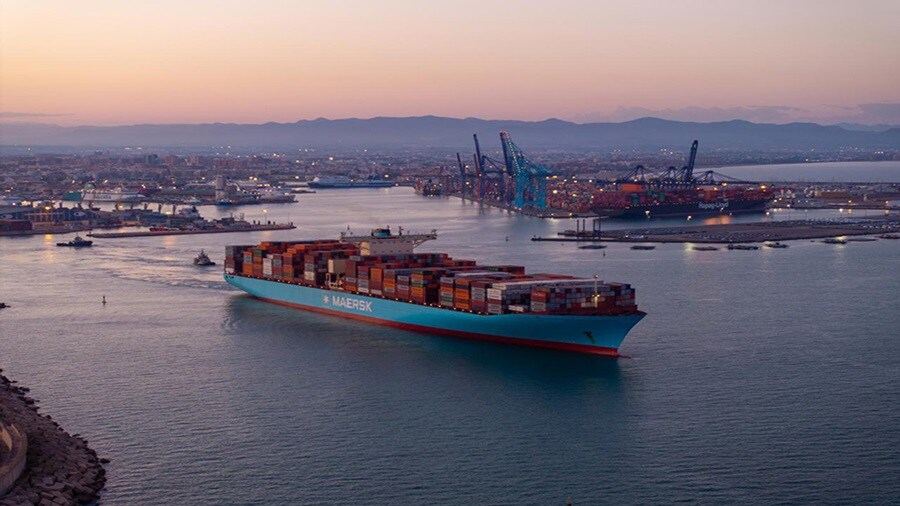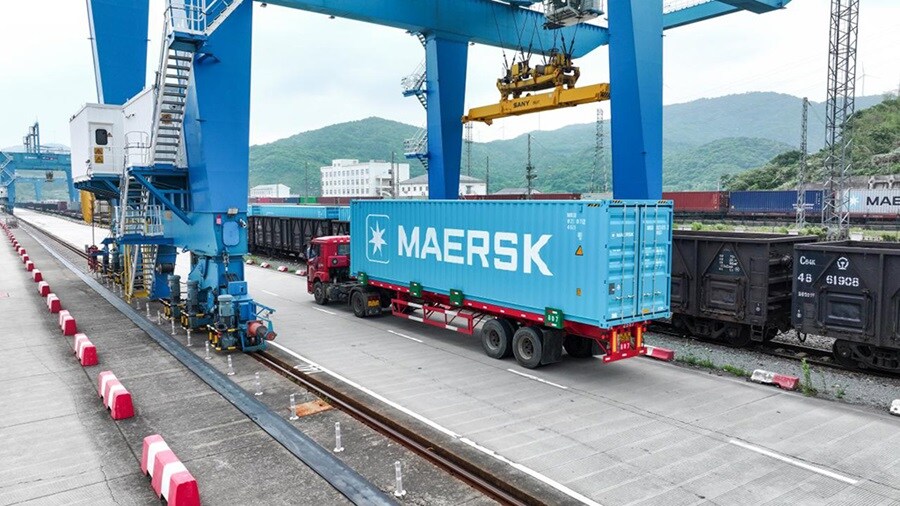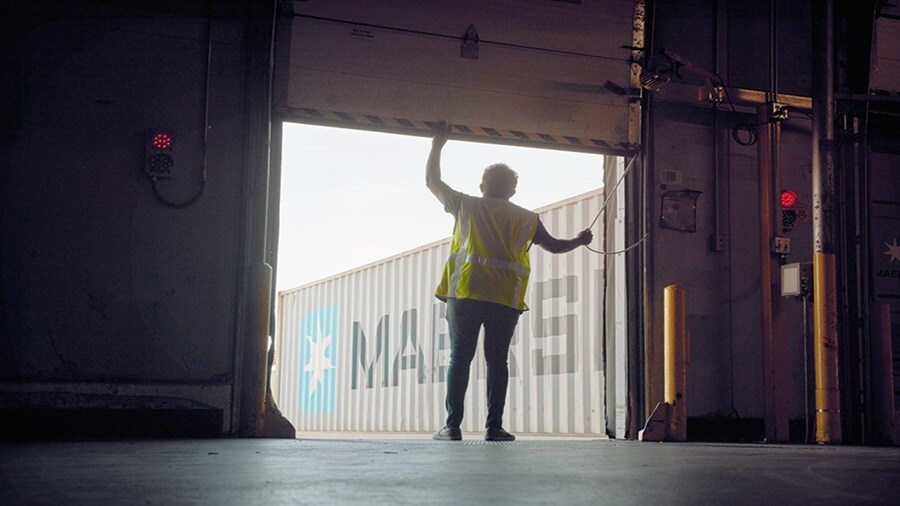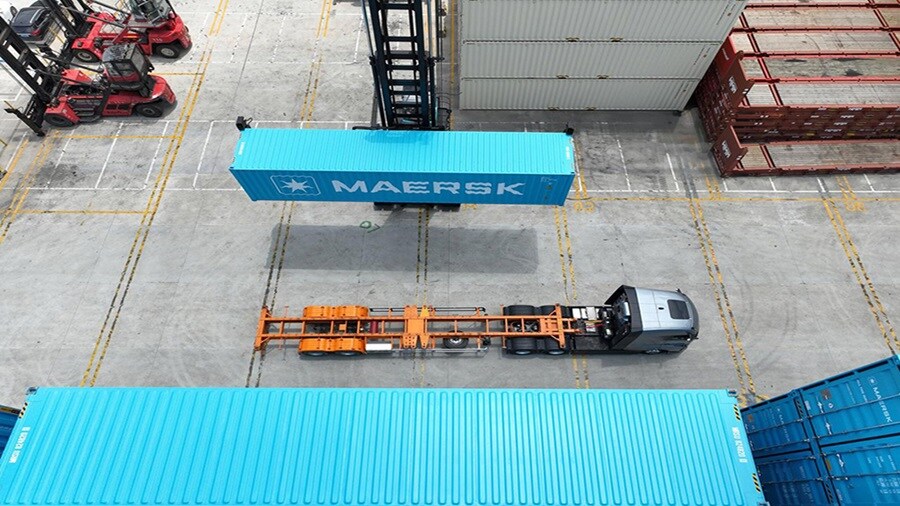As we head into the second half of the year, supply chains are feeling the impact of peak season demand, shifting trade policies, and ongoing capacity challenges. Many of you are adjusting sourcing, transportation, and storage strategies to stay ahead of disruptions. This month, we’ve pulled together the latest updates from our teams across ocean, inland, customs, warehousing, LCL, ground freight, and e-commerce to help you plan more confidently and keep your cargo moving.
To receive Maersk North America Market Update in your inbox, sign up for our logistics newsletter here and update your preferences when prompted via email.
Ocean Update

Europe to North America: Import demand from Europe into the U.S. remains strong, and vessels are full through at least mid-July. Space into the U.S. is limited, but we have capacity available on services to Canada. If you're shipping to Canada, you may be able to improve performance by shifting volume to those lanes.
Tariff uncertainty may impact future booking patterns into the U.S. We're collecting feedback from our customers to better understand how this could affect your planning. If you're adjusting volumes or timelines, let your Maersk contact know so we can support accordingly.
Indian Subcontinent, Middle East and Africa to North America: Services from the Indian Subcontinent and Middle East into North America are entering peak season, although the start appears slightly later than in previous years. Space is tightening across most services, and we expect capacity to remain constrained through the coming weeks. While the Israel-Iran conflict continues to raise concerns, our Middle East network has not experienced significant disruption so far. That said, space remains limited from Red Sea ports, and we advise booking early if you're moving cargo from this region.
West Africa imports are seeing strong demand, and this trend is expected to continue. On South Africa services, citrus season is driving high volumes, and our vessels are currently full, with rolling in effect for July. Dry cargo from the region is also contributing to the pressure on space.
From East Africa, garment and coffee volumes are expected to rise through July and continue at a steady pace. If you're planning shipments from these markets, consider firming up forecasts and securing bookings as early as possible to avoid delays and ensure cargo readiness aligns with sailing schedules.
Asia-Pacific to North America: Transpacific import demand picked up in June, with bookings rebounding after a slower period. Much of the earlier tariff-related backlog has now cleared. In response to stronger volumes, we reinstated vessel capacity that had been downsized earlier in the year to better align with current demand.
Looking ahead, we expect continued space constraints into peak season. The temporary “reciprocal tariff pause” on tariffs between the U.S. and China is set to expire on August 14. While no new changes have been confirmed, we’re closely monitoring developments and potential supply chain impacts. We encourage customers to plan ahead and secure space early, particularly for time-sensitive cargo.
To provide more routing options, we launched the new Transpacific TP9 service on June 24. This service connects Xiamen, Busan, and Long Beach, offering faster transit times and added flexibility from North China and Northeast Asia into the U.S. West Coast.
As we move deeper into peak season, early forecasting and timely bookings will be key to avoiding disruptions. Please reach out to your Maersk representative for the latest space availability or to explore alternate routing options if needed.
To receive the latest updates on your cargo, sign up for ETA notifications or check schedules on Maersk.com. For operational updates in our “Weekly Reader,” subscribe to our advisories at Maersk.com/newsletter.
Customs Update

Tariff uncertainty remains a key issue for importers. The current 90-day suspension on reciprocal tariffs is set to expire in early July. While the U.S. administration has signaled that extensions may be granted to countries actively negotiating trade agreements, the U.K. is the only country that has finalized a deal so far.
The U.S. and China have reached a tentative framework that maintains the existing 10% reciprocal tariff and adds a new 20% tariff related to concerns over fentanyl exports. These are in addition to ongoing Section 301 duties and standard Harmonized Tariff Schedule (HTS) rates. Tariffs on aluminum, steel, and related products have also increased significantly, with some rates now reaching 50%. A 200% tariff applies to aluminum imports when the country of smelt and cast can't be verified.
The tariff landscape continues to shift, with new product categories being added. At the same time, a legal challenge involving importers, several U.S. states, and the federal government is underway. While the courts consider the case, all current tariffs remain in effect.
To stay informed, we’re publishing ongoing tariff advisories and regulatory changes at maersk.com/global-tariffs. We also recently hosted a webinar, Beyond the Tariffs, focused on tools and guidance for navigating this landscape. You can catch the full recording here.
Given the pace and complexity of regulatory change, we encourage importers to regularly review their customs strategies. This includes checking tariff codes, verifying country-of-origin documentation, and evaluating sourcing decisions. Many are also reassessing how they manage Free Trade Agreement (FTA) eligibility and compliance risk.
To support this, we recently introduced Maersk Trade & Tariff Studio, to help importers manage growing complexity in customs and tariff requirements. The solution brings key data and regulatory updates into a single view, making it easier to spot compliance risks early and identify potential duty savings, especially around Free Trade Agreements. It’s currently available for U.S. imports and is meant to support more informed decision-making as trade conditions keep evolving. If you’re interested in learning more about our Pre-Screening service or how this tool might support your customs strategy, contact us at chb.northamerica@maersk.com
For broader customs support, including questions about compliance strategy, documentation, or tariff changes, our Trade Services team is available at compliance.mcsi.nam@maersk.com.
Inland Update

Drayage capacity on the U.S. West Coast is tightening. The arrival of tariff relief cargo is driving up demand for trucks and drivers, especially around Los Angeles and Long Beach. That’s putting pressure on local fleets and the broader inland network. Chassis and rail providers have repositioned assets in Los Angeles, Long Beach, Houston, and Savannah to handle shifting volumes. But since these flows aren’t following typical peak season patterns, equipment is often out of position.
In Southern California, backlogged empties and early arriving imports are slowing rail ramp operations. Inland locations like Chicago and Dallas could see congestion build as more cargo moves inland under tariff reprieve. You may see tighter equipment availability, longer dwell times, and slower container turnarounds.
If you haven’t already, now’s the time to share your volume forecasts with your drayage providers. This helps secure terminal appointments and avoid last-minute delays. Keep an eye on dwell times and inland ramp performance, especially if you’re routing through high-volume corridors. If you’re using Maersk carrier haulage, you may avoid added costs tied to extended driver wait times or missed appointments. Our teams are actively managing these risks to keep your cargo moving.
In Canada, container volumes remain high, especially on the West Coast. Vancouver continues to operate at elevated levels, while Prince Rupert has seen a sharp increase in rail traffic, putting pressure on inland and rail networks. Wildfire risk is expanding across western Canada, and CN rail service may face suspensions or rerouting depending on fire containment. These disruptions could persist into August.
In the East, congestion in Montreal is delaying store-door deliveries, particularly for exports. Road construction around Turcot, Ville Marie, and the La Fontaine Tunnel is adding to the challenge. Terminals in the U.S. Northeast, especially Newark, continue to see high dwell times, which is delaying cargo railing into Canada. Reefer trucking from the U.S. East Coast remains limited, and citrus season is stretching capacity even further.
We’ve added capacity on the West Coast to help reduce pressure on inland lanes and our teams continue to monitor rail terminal performance and escalate issues as needed.
Expect rail delays and plan with extra lead time. If you’re moving special cargo like overweight, refrigerated, or time-sensitive, please share those details early so we can help coordinate. In Montreal, delivery appointments remain inconsistent due to traffic and construction, so flexible scheduling may help avoid missed windows. We expect pressure on reefer and inland services to continue through July. Montreal congestion is slowly improving and may stabilize by the end of the month.
Warehousing Update

In North America, the warehousing market continues to tighten due to constrained labor availability and evolving inventory strategies shaped by ongoing tariff impacts. Many shippers are shifting away from just-in-time models and opting for more flexible storage closer to consumption markets. According to Prologis, elevated inventory levels remain a deliberate strategy, with businesses holding additional stock to buffer against geopolitical and supply chain volatility.
This shift is amplified by rising e-commerce fulfillment requirements and expanding SKU profiles, which require more complex and distributed warehouse setups. Deloitte’s 2025 outlook highlights that retailers are diversifying product assortments and fulfillment options to support omnichannel growth, driving increased demand for dynamic storage and handling solutions.
Front-loading remains a common response to economic uncertainty, as shippers accelerate purchasing ahead of projected cost increases tied to tariffs and broader market conditions. Many importers are advancing shipments before the August 14 expiration of the current suspension on reciprocal tariffs between the U.S. and China adding further pressure to warehouse capacity and port operations.
In response, we’re continuing to expand our footprint across North America. We’re also enhancing scalability through tech-enabled visibility tools like Warehouse Management Systems (WMS) and Yard View. These platforms are integrated into our broader logistics network, enabling faster turnarounds, smoother cargo transfers, and tighter control of dwell time and cost.
Looking ahead, we recommend locking in space commitments early, especially ahead of peak season. Flexible multi-user warehouses offer scalable alternatives to static, dedicated sites. Value-added services, including pick/pack, labeling, and cross-docking can help streamline operations. Shippers using dray-direct-to-transload services are also seeing improved throughput and reduced detention costs. Transloading remains a key lever for cost savings as storage fees rise.
While some businesses are working through early-arrival inventory, others continue production to avoid future stockouts despite tariff pressure. We’re also seeing a shift toward smaller, regional warehousing nodes as customers look to manage landed costs more aggressively. With macroeconomic and geopolitical conditions still in flux, flexibility remains critical. We’ll continue supporting warehousing and distribution strategies that help you maintain service levels while managing cost.
Less than Container Load (LCL) Update

Many supply chains are still operating in reactive mode. With ongoing uncertainty around tariffs, sourcing shifts, and transportation delays, it’s difficult to plan with confidence. When things don’t go as expected, whether it’s missed delivery windows, inventory gaps, or urgent shipments, costs add up quickly. That includes expedited transport, unplanned airfreight, or missed contract obligations.
LCL continues to offer flexibility for shipments that don’t fill a full container. It allows you to move smaller volumes more frequently, which can help reduce the risk of overstocking or holding inventory in the wrong place. This is especially useful when demand signals are inconsistent or when managing split shipments across multiple suppliers.
We’re seeing that more customers are moving time-sensitive cargo from air to LCL, especially where inland delays and rail congestion are a factor. Truck-based IPI services are helping cut down on handoff delays and reduce dwell time. For some trade lanes, ocean-based LCL is a more reliable option for products that previously required air.
If your team is reviewing transportation plans for the year’s second half, consider where smaller, frequent shipments might reduce risk and improve flow. LCL isn’t always the right fit, but in the current environment, it’s worth looking at how it might support better timing, lower exposure to disruption, and greater control over landed cost.
Ground Freight Update

Ground freight conditions in Canada remain fluid as tariff changes and seasonal shifts continue to affect both cross-border and domestic markets. The newly imposed 50% U.S. tariff on steel and aluminum has introduced more volatility across key lanes. Some carriers have paused or rerouted U.S.-bound shipments, especially those tied to raw materials. While cross-border volumes remain elevated, service reliability has declined on these affected corridors.
Domestically, equipment availability remains uneven. The ongoing U.S. produce season is pulling dry van capacity into refrigerated service, creating pressure in certain regions. At the same time, a shift in consumer demand toward locally sourced goods is reducing cross-border movements and lowering average shipment tonnage.
These shifts are resulting in longer transit times, narrower lead windows, and more frequent rate fluctuations, particularly on steel-related lanes. To help stabilize operations, we recommend building flexibility into your routing plans, reviewing rate agreements for mid-term alignment, and staying closely connected with your logistics teams for real-time adjustments.
Maersk is actively optimizing domestic routing and sharing weekly insights to help you manage through these conditions. While negotiations between Canada and the U.S. continue, we expect current constraints to remain in place through the summer. For lane-specific support or planning guidance, please reach out to your Maersk representative.
For additional insights on the latest trends shaping the North American ground freight market, see our recent update here.
E-Commerce Update

E-commerce shipping across North America is entering a period of complexity. Tariff changes, new trade regulations, and pricing shifts from major carriers are putting pressure on last-mile strategies. At the same time, the growth of regional carriers is expanding options, but also introducing new variables in consistency, coverage, and SLA management.
Shippers are reevaluating how they structure their networks to balance speed, cost, and flexibility. Through our e-commerce logistics network, we are seeing many businesses shift toward fulfillment models that reduce final-mile distance and improve delivery consistency. This includes diversifying carrier mix, redesigning rate strategies, and adjusting lead times to account for volatility in both service and cost.
Returns and reverse logistics are also receiving more attention. Paperless returns, local drop-off options, and simplified workflows are becoming more common, especially as consumers expect faster, more flexible experiences. This is particularly relevant heading into peak season, where inefficiencies in returns can create downstream delays and added costs.
Planning for Q4 is already underway. With capacity tightening and peak surcharges expected, businesses are locking in last-mile volume early and reviewing how to best maintain delivery performance. Across the board, transparency has become a primary focus, knowing exactly what you'll pay, where your package is, and whether it will arrive on time.
Real-time network visibility and adaptive routing have become essential to maintaining SLA integrity. Our e-commerce operations use these tools to respond quickly to disruptions and reroute parcels without compromising delivery windows. This flexibility is helping shippers manage through increasing complexity while holding service levels steady.
If you haven’t started preparing for peak, now is the time to review network design, rate exposure, and capacity coverage. Our E-commerce Teams are already working with customers to model peak demand scenarios and secure capacity ahead of Q4.
More News & Insights from Maersk from around the world
- Ground reality: what Q1 freight trends reveal about the road ahead
- Maersk launches “Maersk Trade & Tariff Studio” helping global supply chains navigate tariff volatility and complexity
- Warehouse, Hub and Distribution Center Trends and Strategies for 2025
Visit our Insights Hub where we share the latest trends in supply chain digitization, sustainability, growth, resilience, and integrated logistics.
Useful links
To sign up for the Maersk North America Market Update newsletter, click here and update your preferences when prompted via email.
Check Maersk market updates from across other regions by clicking here.
Anything you need, we’re here to help
I agree to receive logistics related news and marketing updates by email, phone, messaging services (e.g. WhatsApp) and other digital platforms, including but not limited to social media (e.g., LinkedIn) from A. P. Moller-Maersk and its affiliated companies (see latest company overview). I understand that I can opt out of such Maersk communications at any time by clicking the unsubscribe link. To see how we use your personal data, please read our Privacy Notification.
By completing this form, you confirm that you agree to the use of your personal data by Maersk as described in our Privacy Notification.

